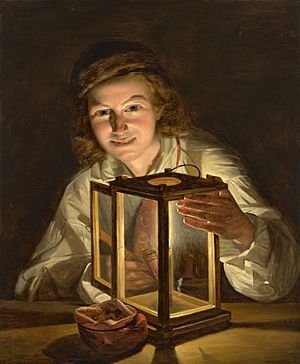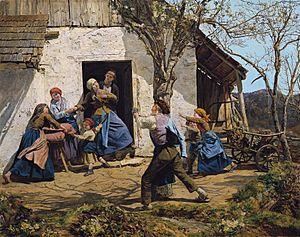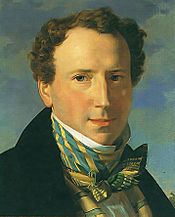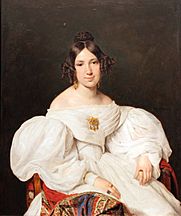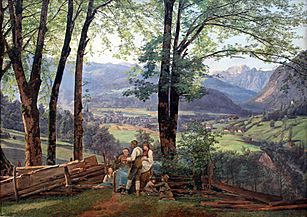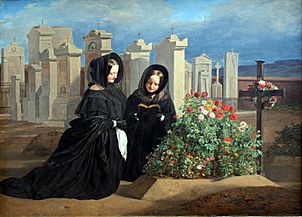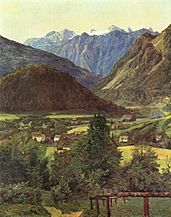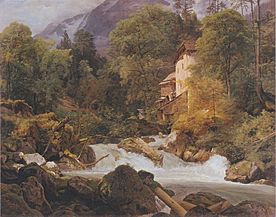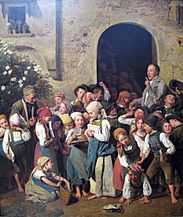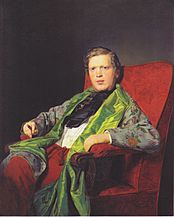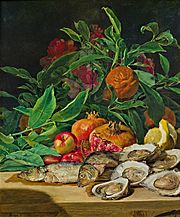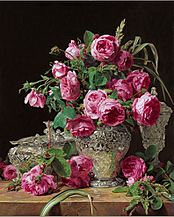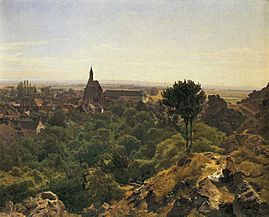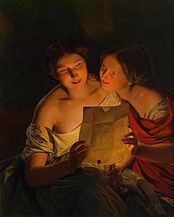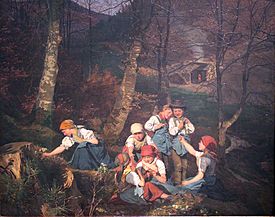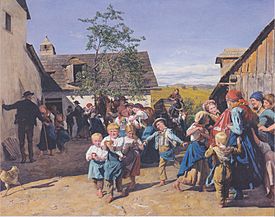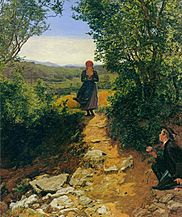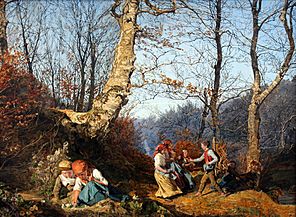Ferdinand Georg Waldmüller facts for kids
Ferdinand Georg Waldmüller (born January 15, 1793 – died August 23, 1865) was a famous Austrian painter and writer. He is known as one of the most important artists from the Biedermeier time in Austria. The Biedermeier period was a time in Central Europe when people focused on simple, cozy home life and art.
Contents
Becoming a Painter: Waldmüller's Early Career
In 1807, when he was 14, Waldmüller started studying at the Academy of Fine Arts Vienna. This was a special school for artists. Later, he lived in Bratislava.
In 1811, he worked as an art teacher. He taught the children of Count Gyulay in Croatia. After this, he went back to the Vienna Academy. There, he focused on painting portraits of people.
In 1814, he married a singer named Katharina Weidner. He traveled with her and worked as a set designer for plays.
Developing His Art Style
In 1817, Waldmüller returned to Vienna. He spent a lot of time copying paintings by "old masters." These were famous artists from the past. He also painted portraits, everyday scenes (called genre subjects), and still-life paintings. Still-life paintings show objects like fruit or flowers.
In 1823, he painted a portrait of the famous composer Ludwig van Beethoven.
Later, Waldmüller became very interested in nature. He began painting beautiful landscapes. He paid great attention to every small detail in his nature paintings. He believed that artists should study nature very closely. These landscape paintings are his most famous works. His amazing use of color and knowledge of nature made him a master.
Challenges at the Academy
In 1819, Waldmüller became a professor at the Academy of Fine Arts Vienna. However, he often disagreed with the people in charge. He wanted the Academy to focus more on studying nature. This was different from their old ideas about "ideal art."
He even published his ideas about art education. Because of his strong views, he was forced to retire in 1857. But by 1863, he was welcomed back into Vienna's art world. He was even given a special honor in 1865.
Ferdinand Georg Waldmüller was a very important Austrian painter. He was great at showing how close or far things were in landscapes. He also captured people's faces perfectly. He could show textures in great detail. He painted scenes from everyday country life. His works were bright, clear, and sometimes showed what he thought about society. He influenced many artists after him.
He believed in painting outdoors, directly from nature. This was called "plein air painting." He also questioned the old ways of teaching art. In many ways, he was ahead of his time.
Waldmüller passed away on August 23, 1865, in Hinterbrühl, Austria.
Artworks Taken During World War II
Ferdinand Georg Waldmüller was one of Adolf Hitler's favorite artists. During the time of the Nazis (1933–1945), many of Waldmüller's paintings were unfairly taken. These artworks were seized from Jewish collectors. Some of them ended up in Hitler's planned museum in Linz.
After the war, many people tried to get their stolen artworks back. Here are some examples of Waldmüller's paintings that were taken:
- Children on Their Way Home from School was stolen from Amalie Redlich.
- Little Count Esterhazy was taken from the Bloch-Bauer collection.
- "Bildnis der Familie Gierster" was stolen from Franz and Melania Popper.
- Wiedergenesene was taken from Hermann Eissler.
- Irma and Oscar Lowenstein had three Waldmüller paintings taken. These included The Good-Natured Child, Preparing the Celebration of the Wine Harvest, and The Grandparents’ Visit.
Gallery
See also
 In Spanish: Ferdinand Georg Waldmüller para niños
In Spanish: Ferdinand Georg Waldmüller para niños
- List of Orientalist artists
- Orientalism


